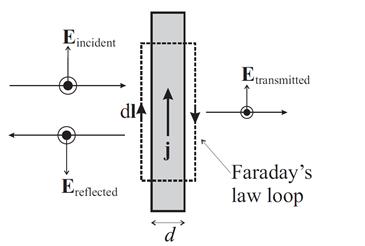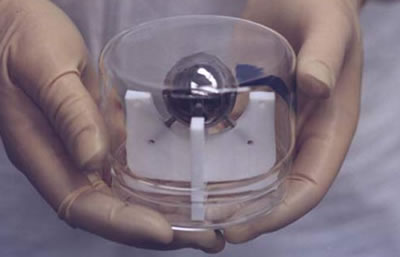Science Fiction
Dictionary
A B C D E F G H I J K L M N O P Q R S T U V W X Y Z
Mirrors For Gravitational Waves

Is it possible to have a surface that could reflect gravitational waves? In a recent paper, Stephen J. Minter, Kirk Wegter-McNelly and Raymond Y. Chiao speculate that thin superconducting films would be highly reflective mirrors for gravitational microwaves.
This is the basis on which a gravitational wave can interact with a superconducting sheet. “Quantum delocalization causes the Cooper pairs of a superconductor to undergo non-geodesic motion relative to the geodesic motion of its ionic lattice,” says Chiao and buddies.
They speculate that this difference in motion causes the sheet to absorb energy from the gravitational wave and then re-radiate it as gravitational wave travelling in the opposite direction–in other words specular reflection.
The new idea comes from considering what happens to a superconducting sheet when a gravitational wave passes by. The Cooper pairs within the sheet are quantum objects governed by the uncertainty principle and so cannot have specific trajectory: they are entirely delocalised. On the other hand, the ions that make up the crystal structure of the superconductor are not delocalised and so can move along a geodesic trajectory when a gravitational wave passes.
(How superconducting sheets could reflect gravitational waves [MIT article])

(Diagram of gravitational wave mirror)
Science fiction fans may well reflect on this research, since they've seen similar ideas more than a century ago. In his 1901 novel The First Men in the Moon, H.G. Wells wrote about a material called "cavorite" that was opaque to gravitation.
On the 14th of October, 1899, this incredible substance was made!
Oddly enough, it was made at last by accident, when Mr. Cavor least expected it. He had fused together a number of metals and certain other things - I wish I knew the particulars now ! - and he intended to leave the mixture a week and then allow it to cool slowly...
..."You are quite clear that the stuff is opaque to gravitation, that it cuts off things from gravitating towards each other? "
"Yes," said I. "Yes."
(Read more about Wells' Cavorite)
Once it becomes clear that Cavorite is "impervious to gravitation", the two men design a spherical spacecraft with special features that would allow them to steer the craft.
"You would go off in a straight line--" I stopped abruptly. "What is to prevent the thing traveling in a straight line into space for ever?" I asked. "You're not safe to get anywhere, and if you do--how will you get back?"
"I've just thought of that," said Cavor. "That's what I meant when I said the thing is finished. The inner glass sphere can be air-tight, and, except for the manhole, continuous, and the steel sphere can be made in sections, each section capable of rolling up after the fashion of a roller blind. These can easily be worked by springs, and released and checked by electricity conveyed by platinum wires fused through the glass. All that is merely a question of detail. So you see, that except for the thickness of the blind rollers, the Cavorite exterior of the sphere will consist of windows or blinds, whichever you like to call them. Well, when all these windows or blinds are shut, no light, no heat, no gravitation, no radiant energy of any sort will get at the inside of the sphere, it will fly on through space in a straight line, as you say. But open a window, imagine one of the windows open. Then at once any heavy body that chances to be in that direction will attract us--"
I sat taking it in.
"You see?" he said.
"Oh, I see."
"Practically we shall be able to tack about in space just as we wish. Get attracted by this and that."
(Wells' Cavorite)
This question of how gravitation might affect a sphere coated with a material that reflects gravity waves is particularly interesting, given recent questions about the behavior of Gravity Probe B, a orbiting experiment consisting of four perfectly round spheres, that spin rapidly and thus behave like gyroscopes. Each sphere has a thin superconducting coating.
The four gyroscopes in GP-B are the most perfect spheres ever made by humans. These ping pong-sized balls of fused quartz and silicon are 1.5 inches across and never vary from a perfect sphere by more than 40 atomic layers.
(Space.com)

(Spherical gyroscope used in Gravity Probe B)
If there were an obvious interaction between a superconducting films and gravitational waves, wouldn't Gravity Probe B have picked them up somehow? After all, in his previous paper Chiao says that a superconducting sphere is the perfect shape for a graviational wave antenna.As it turns out, the experiment has been throwing out anomalous results ever since it was launched. The team has puzzled over them for years now and lately come to the conclusion that they are the result of some imperfections in the shape of the spheres. This seems rather unlikely given the testing regime that Gravity Probe B underwent during its tortuous history.
Could the real cause of Gravity Probe B's problems be reflections from passing gravitational waves?
(If superconducting sheets reflected gravitational waves...)
Read more at If superconducting sheets reflected gravitational waves..., How superconducting sheets could reflect gravitational waves and Laboratory-scale superconducting mirrors for gravitational microwaves (pdf); read more about Gravity Probe B in NASA Collects Gravity Data to Test Einstein's Theory. Thanks to Winchell Chung for the tip and sf reference for this story.
Scroll down for more stories in the same category. (Story submitted 3/24/2009)
Follow this kind of news @Technovelgy.| Email | RSS | Blog It | Stumble | del.icio.us | Digg | Reddit |
Would
you like to contribute a story tip?
It's easy:
Get the URL of the story, and the related sf author, and add
it here.
Comment/Join discussion ( 3 )
Related News Stories - (" Space Tech ")
Will Space Stations Have Large Interior Spaces Again?
'They filed clumsily into the battleroom, like children in a swimming pool for the first time, clinging to the handholds along the side.' - Orson Scott Card, 1985.
Reflect Orbital Offers 'Sunlight on Demand' And Light Pollution
'I don't have to tell you about the seven two-mile-diameter orbital mirrors...'
Chrysalis Generation Ship to Alpha Centauri
'This was their world, their planet —
this swift-traveling, yet seemingly moveless vessel.' - Nat Schachner, 1934
The First Space Warship For Space Force
'Each of the electrical ships carried about twenty men...' - Garrett P. Serviss, 1898.
Technovelgy (that's tech-novel-gee!) is devoted to the creative science inventions and ideas of sf authors. Look for the Invention Category that interests you, the Glossary, the Invention Timeline, or see what's New.
Science Fiction
Timeline
1600-1899
1900-1939
1940's 1950's
1960's 1970's
1980's 1990's
2000's 2010's
Current News
The Zapata Air Scooter Would Be Great In A Science Fiction Story
'Betty's slapdash style.'
Thermostabilized Wet Meat Product (NASA Prototype)
There are no orbiting Michelin stars. Yet.
Could Crystal Batteries Generate Power For Centuries?
'Power could be compressed thus into an inch-square cube of what looked like blue-white ice'
India Ponders Always-On Smartphone Location Tracking
'It is necessary... for your own protection.'
Amazon Will Send You Heinlein's Knockdown Cabin
'It's so light that you can set it up in five minutes by yourself...'
Is It Time To Forbid Human Driving?
'Heavy penalties... were to be applied to any one found driving manually-controlled machines.'
Replace The Smartphone With A Connected Edge Node For AI Inference
'Buy a Little Dingbat... electropen, wrist watch, pocketphone, pocket radio, billfold ... all in one.'
Artificial Skin For Robots Is Coming Right Along
'... an elastic, tinted material that had all the feel and appearance of human flesh and epidermis.'
Robot Guard Dog On Duty
I might also be thinking of K-9 from Doctor Who.
Wearable Artificial Fabric Muscles
'It is remarkable that the long leverages of their machines are in most cases actuated by a sort of sham musculature...'
BrainBridge Concept Transplant Of Human Head Proposed
'Briquet’s head seemed to think that to find and attach a new body to her head was as easy as to fit and sew a new dress.'
Google's Nano Banana Pro Presents Handwritten Math Solutions
'...copy was turned out in a charming and entirely feminine handwriting.'
Edible Meat-Like Fungus Like Barbara Hambly's Slunch?
'It was almost unheard of for slunch to spread that fast...'
Sunday Robotics 'Memo' Bot Has Unique Training Glove
'He then started hand movements of definite pattern...'
Woman Marries Computer, Vonnegut's Dream Comes True
'Men are made of protoplasm... Lasts forever.'
Natural Gait With Prosthetic Connected To Nervous System
'The leg was to function, in a way, as a servo-mechanism operated by Larry’s brain...'
